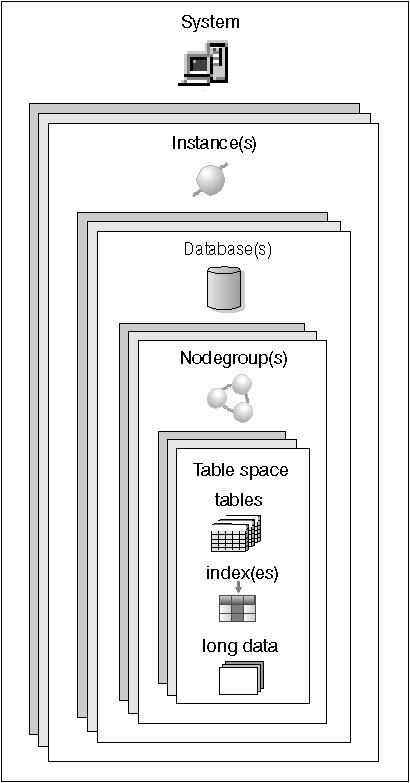

A database manager (sometimes called an instance) is DB2 code that manages data. It controls what can be done to the data, and manages system resources assigned to it. Each instance is a complete environment. It contains all the database partitions defined for a given parallel database system. An instance has its own databases (which other instances cannot access), and all its database partitions share the same system directories. It also has separate security from other instances on the same machine.
A nodegroup is a set of one or more database partitions. When you want to create tables for the database, you first create the nodegroup where the table spaces will be stored, then you create the table space where the tables will be stored. See Nodegroups and Data Partitioning for more information about nodegroups. See Overview of DB2 Parallelism Concepts for the definition of a database partition.
A database is organized into parts called table spaces. A table space's definition and attributes are recorded in the database system catalog. Once a table space is created, you can then create tables within this table space. A container is assigned to a table space. A container is an allocation of physical storage (such as a file or device). Table spaces reside in nodegroups.
A table consists of data logically arranged in columns and rows. The data in the table is logically related, and relationships can be defined between tables. Data can be viewed and manipulated based on mathematical principles and operations called relations. Table data is accessed via SQL, a standardized language for defining and manipulating data in a relational database. All database and table data is assigned to table spaces.
A query is used in applications or by users to retrieve data from a database. The query uses Structured Query Language (SQL) to create a statement in the form of
SELECT <data_name> FROM <table_name>
In this chapter we use the term "query" to identify a retrieval request (a SELECT statement) from a database.
Figure 1 illustrates the relationship among the objects just described. It also illustrates that tables, indexes, and long data are stored in table spaces.
Figure 1. Relationship Among Some Database Objects
 |